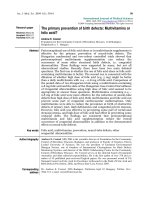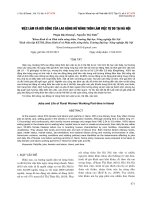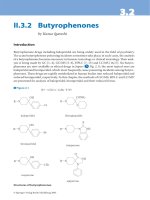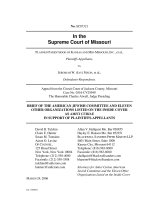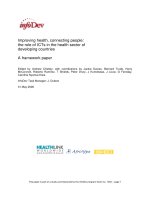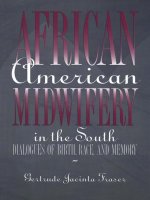African American Midwifery in the South Dialogues of Birth, Race, and Memory pptx
Bạn đang xem bản rút gọn của tài liệu. Xem và tải ngay bản đầy đủ của tài liệu tại đây (797.42 KB, 300 trang )
African American Midwifery
in the SouthAfrican American Midwifery
in the South
Dialogues of Birth, Race,
and Memory
Gertrude Jacinta Fraser
HARVARD UNIVERSITY PRESS
Cambridge, Massachusetts
London, England
1998
Copyright © 1998 by the President and Fellows of Harvard College
All rights reserved
Printed in the United States of America
Library of Congress Cataloging-in-Publication Data
Fraser, Gertrude Jacinta.
African American midwifery in the South : dialogues of birth,
race, and memory / Gertrude Jacinta Fraser.
p. cm.
Includes bibliographical references and index.
ISBN 0-674-00852-9
1. Afro-American midwives—Virginia—History—20th century.
2. Midwifery—Virginia—History—20th century.
3. Childbirth—Virginia—History—20th century. I. Title.
RG950.F7 1998
618.2
Ј
0233—dc21 97-38661
For Maya Fraser Butler and
Gladys Barnes Fraser
Acknowledgments
ix
Prologue
1
I THE BODY POLITIC
1Introduction
25
2 Midwives and the Body Politic
43
3 Race and Regulation
59
4 Race and Mortality
79
II AUTHORITATIVE KNOWLEDGE
5 Nurses and Midwives in the Classroom
107
6 The Logic of Prenatal Care
125
III MEMORY AND EXPERIENCE
7 On Silence and Memory
139
8 Changed Bodies, Changed Communities
163
9 The Social Context of Midwifery
181
10 Pregnancy and Birthing
213
11 The Postpartum
239
12 Conclusion
257
Notes
265
References
269
Index
283
Without the support and sustenance of family and friends, the encour-
agement of mentors and teachers, and the generosity of institutions, I
could not have completed this book. Most of all, I am greatly indebted to
the residents of Green River County, Virginia. Although I am unable to
name them individually, I thank them for allowing me into their homes
and lives.
Most recently, I received a sesquicentennial leave for 1995–96 from
the University of Virginia to complete revisions for this work. Without
teaching obligations, I was able to devote my full attention to the task at
hand. I am very grateful. Early in my work, the Carter G. Woodson
Institute for African and Afro-American Studies at the University of Vir-
ginia provided me with access to excellent library resources, gave me
office space, offered the expertise of its capable staff, and valued my work
when it was still in its embryonic stages. A two-year predoctoral fellow-
ship allowed me to work in a supportive and intellectually challenging
environment. The institute’s director, the late Armstead Robinson, gave
fully of himself, and I miss his presence. A Ford Foundation postdoctoral
fellowship funded me during a year of archival research and writing. I
salute them for their support of minority scholars and of my project.
The Department of Anthropology at the Johns Hopkins University
provided me with generous financial support during my graduate career.
I have had the good fortune to work closely with fellow students and
with teachers who pushed me to ask difficult questions and to break
down the disciplinary barriers that would restrict inquiry. The Seminar
in Atlantic History and Culture provided an always lively forum for the
critical discussion of issues related to the African diaspora. It is
impossible to unravel the threads of the many conversations and critical
insights now woven into the fabric of my work. These provided me with
my first exposure to the scholarship that would define my subsequent
research interests.
ix
I am grateful to Sidney Mintz, who first introduced me to the field
of African American anthropology. He has been a tough and exacting
teacher. I thank him for his early attention to this manuscript and to the
progress of my development as an anthropologist. Emily Martin has
given me the benefit of her considerable expertise on the subjects of
science and childbirth and also provided me with a model of a commit-
ted feminist scholar and teacher. My colleagues in the Department of
Anthropology at the University of Virginia have always provided good
cheer and scholarly inspiration. This manuscript has also benefited from
a close reading by anonymous reviewers for Harvard University Press.
Sections of Chapter 8 appeared in
Conceiving the New World Order: The
Global Politics of Reproduction,
edited by Faye D. Ginsburg and Rayna
Rapp, copyright © 1995 the Regents of the University of California, used
by permission.
All responsibilities for errors of fact and analysis are mine, but the
book is in the end a product of many years’ conversation.
As for my family, I cannot conceive of my life without them. My
mother, Gladys Barnes Fraser, has offered inspiration and example. She
has loved me without reservation, and that has always kept me going. I
want also to express my gratitude to my sister Angella, who has walked
with me every step of this journey and has given good computer consul-
tation as a bonus. To my brother Mark and family, thanks for the free
baby-sitting and for your loud cheerleading. Reginald Butler has been my
fellow traveler. He has listened and read, carefully and repeatedly. With
hard work, he has made a halfway decent historian out of an anthropolo-
gist by giving willingly of his knowledge of African American history and
culture in Virginia. To my three-and-a-half-year-old daughter, Maya, who
always asked “When is your book going to be finished?”: here it is, and
thank you for all the good loving and kisses.
x
Acknowledgments
African American Midwifery
in the South
Within the past decade, scholars have begun to reveal the important role
African American midwives played in the reproductive experiences of
southern women, both black and white. This book is a contribution to
the documentation of that African American presence. It is also a re-
quiem to the knowledge, skills, and beliefs that have been lost. If, thanks
to the classic movie
Gone with the Wind,
popular imagery has the African
American woman faced with the prospect of having to help deliver a
baby being completely hysterical, then recent scholarship counters that
portrayal. It instead provides one that illuminates the long competence
of such women in reproductive medicine. The full impact of this collec-
tive scholarship should lead to a rereading of that scene, so that the
refusal to reveal knowledge of birthing can be interpreted as an act of
deliberate resistance.
Since I began my fieldwork in the mid-1980s and continuing to the
present, I have talked to older African Americans in one Virginia com-
munity about the material and symbolic shifts in birth that they saw oc-
curring in their lifetimes. Early on it became apparent that the memories
of midwifery’s presence and absence required me to look beyond Green
River County to understand why African American lay midwives, so vital
to the reproductive health care in their communities, got pushed aside.
Stories of midwifery in Green River County foregrounded the natural
disappearance of midwives and home births as if that aspect of people’s
experience had simply ceased to exist. The naturalizing of this historical
phenomena was one way for residents to give explanatory order to the
past. I wondered, however, about other ways of telling the same story.
1
The evocation of “why” in social science methodology implies that
patterns of cause and effect are to be discerned. In this work, I prefer to
think of the “why” question as a prelude to unraveling a thickly embroi-
dered tapestry. In the near decade of my intellectual and emotional in-
volvement in the story of African American midwives in the South, I
found no single set of explanations that satisfactorily answered all my
questions. How and under what circumstances did African American
women lose their foothold in birthing babies and attending pregnant and
laboring mothers in their communities? In always asking why the South
gave up on African American midwives, I wanted to remember that the
erasure of these women’s roles and skills in birthing should not be taken
for granted as an inevitable outcome of medical progress and profession-
alization. The book points out other paths that had been cleared, but
then abandoned, in the journey to the dismantling of southern mid-
wifery.
In my discussion of ethnographic fieldwork in Green River County or
medical and public health programs from 1900 to 1960, I focus as much
on language and the territory of discourse as on what people and institu-
tions did or how they did it. This approach undoubtedly marks me as a
product of a particular time and place in the history of anthropology, and
specifically of medical anthropology. No apologies are forthcoming; I can
only say that much of the data from conversations with residents in
Green River pivot around the complex reconstruction of experience and
the selective strategies of memory—that is, around talk. Similarly, the
writings and programs produced by physicians, nurses, and public
health officials contained a universe of ideas about race and gender, the
relationship of medicine to society, and the status of the South in the
nation’s political and social economies. These ideas reflected the world as
these authors knew it and established a way of ordering that world in the
face of the dramatic transitions that were under way.
Remembering and Forgetting
I am drawn to the nature of remembering and forgetting in the histories
and cultures of birthing practitioners and practices. Most current authors
allude to the ways in which the African American midwife has been
ignored. For example, Rene Reeb describes African American midwives
in rural Mississippi as one of the state’s “best kept secrets” (1993, 20).
The erasure of historical memory about the skills and knowledge of these
2
Prologue
African American women existed alongside moments when they have
figured on the national and local stage. In this book, I focus on the period
from the 1920s to 1950s, when the African American midwife was
drafted into service in the social and medical reform initiatives of local
state legislatures and the federal government. There were and are other
instances suggestive of how the African American midwife has repre-
sented a cultural cypher with which others have written their own narra-
tives or blocked alternative readings. This Prologue addresses the rudi-
ments of these interpretive entanglements.
The African American midwife showed up in a most unlikely place
when reporter Michael Lewis filed a “postcard” from Montgomery, Ala-
bama, to the pages of
The New Republic
in August 1993. He reported on
his meeting with Onnie Lee Logan, a retired African American midwife
who is the subject of
Motherwit: An Alabama Midwife’s Story,
an “as told
to” book by Katherine Clark (1989). A one-woman reading had been
adapted from the work (with hopes of a more ambitious play), thus
providing the occasion for Lewis’s duties as a chauffeur to bring Miss
Onnie from Mobile to Montgomery for the reading.
Lewis notes the unlikely reversal of roles in which Miss Onnie was the
honored guest celebrity and white men her supplicants. He characterizes
Miss Onnie’s refusal to dwell on tragedy in her life or to emphasize her
experience of racism and professional neglect as a rebuke to those who
would use her life to comment on the history and politics of race and
racism. The seeming absence of bitterness, in Lewis’s view, “posed a
problem for modern sensibilities. For a start, a black woman who had
suffered the full indignity of pre civil rights Alabama yet does not see
herself as a victim threatens those who do” (1993, 11). The dominant
note struck in this doubling back on the midwife as public figure—in the
text and play and as celebrity—is the veiled insistence on Lewis’s part
(and not really Miss Onnie’s) that her life remain resolutely individual-
ized, sheared from social or historical context. Lewis wants us to take
Miss Onnie at face value. That desire has its own conservative motiva-
tion. It challenges those of us who would want to give Miss Onnie her
due, while insistently speaking to and offering evidence of her victimiza-
tion, by whom and for what. Lewis’s commentary reflects the kinds of
issues that emerge in the question of how the African American midwife
and her history should be depicted today. Such a challenge is an old one,
with perhaps as much at stake in the present, when few traditional
midwives remain, as in the past, when they numbered in the thousands.
Prologue
3
One remarkable moment in the public depiction of the midwife oc-
curred in December 1951, when in a photo-essay for
Life
magazine, W.
Eugene Smith introduced Mrs. Maude Callen, a nurse midwife practicing
in rural South Carolina. The photo-essay, sandwiched between advertise-
ments for automobiles by Packard and watches by Longine, showed
striking and sympathetic images of the midwife attending a young
woman through labor and delivery, nursing the sick and shutin, offering
a postnatal check to a poor white mother of twins, helping poor African
American residents negotiate business transactions, teaching lay mid-
wives, and assisting the local white physician. While highlighting the
competence, caring, and heroism of Mrs. Callen, the
Life
photographs
also depicted the substandard living conditions of rural African Ameri-
cans. Malnourished young children were shown dancing at having re-
ceived a hand-me-down dress or a few store-bought groceries from the
midwife (Smith 1951).
1
It is not coincidental that these images and text appeared in the
Christmas issue.
Life
readers could recognize their own good fortune,
while being moved to consider the depressed social conditions of the
southern “Negro.” As Glenn Willumson documents, barring a few nasty
letters to the editor, public response to the photo-essay was overwhelm-
ingly positive: donations to Mrs. Callen allowed her to build and estab-
lish a medical clinic for African American patients. The
Life
photo-essay
also influenced the state legislature to increase funds to public health,
which previously had been steadily cut (Willumson 1992, 167–77). In
addition to touching the hearts of readers and legislators, however, Smith
intended his story to serve as an ideological counter to the view that
African Americans were morally and intellectually deficient (Willumson
1992). By showing the collaboration of an African American midwife
and a white doctor, he offered an alternative vision of racial relations in
the South and pressed for the importance of increased opportunities for
midwifery training.
As a cypher, however, Maude Callen had been carefully selected. She
was a college-trained nurse, with a physician uncle and good connec-
tions among the public health bureaucracy and local religious philan-
thropies (Willumson 1992). Willumson is highly critical of Smith’s delib-
erate muting of these facts. With the benefit of foresight, he suggests that
the photo-essayist’s call for increasing the number of African American
midwives could have been detrimental to what would have been the
4
Prologue
higher goal of medical integration. He is particularly put off by the lop-
sided portrayal of Mrs. Callen as a hero-martyr—a rural woman strug-
gling to make good by the force of her own will and native intelligence.
Smith’s photo-essay worked because it tapped into a cultural icono-
graphy of African Americans in which humility and forbearance were
paired. Mrs. Callen worked to exhaustion and was smart, but she never
expressed anger or stepped outside the appropriate bounds. She looked
the part of a midwife, but not in any alien or frightening way. She moved
among the African American poor without being too aggressively differ-
ent or too much herself a part of that milieu. I see these photographs as
reassuring in some ways, at least for white readers of
Life,
because they
allowed whites into the homes and communities of the racial and eco-
nomic outsider. Furthermore, by ostensibly focusing on the midwife’s
activities, Smith was able to show scenes of a mother in labor, in tears, in
pain, as well as the contorted body of a child near death—moments of
such intimacy—that were only available for public consumption in a
family magazine because the subjects were African American, southern,
and poor.
2
For Smith and others, portrayals of the midwives were linked
to a specific set of representations of the African American body and of
African American families and communities. These operated in a com-
mon fashion, even if the underlying political motivations were wildly
divergent.
I show how such public representations appear in the cultural frames
of African American residents in Green River County. I indicate, where I
can, how residents attempted to shape that public image, particularly
through the ethnographic interventions made available to them by virtue
of my presence and nagging questions while conducting this research.
On Margins
The margin is a key metaphor in a recent work by Arthur Kleinman,
a physician and perhaps one of the best known and most influential
contemporary medical anthropologists (1995). Medical anthropology, he
writes, operates at the boundaries between different disciplines. It com-
ments on the relations among medicine, health, the body, and society but
takes a decided and critical stance on the outskirts. Besides the image of
the intellectual borderlands as a good place to tackle such issues, I like
Kleinman’s invocation of margins as a methodological feature of medical
Prologue
5
anthropology’s engagement with ethnography. This, as he puts it, “cre-
ates another world and compares it with the taken for granted one”
(1995, 195). Ethnography involves writing in from the margins, and in
the process it encourages a repositioning of the center. Other definitions
may offer more complexity, but Kleinman’s perspective on ethnography
suits my approach to this study.
Fairly stated, chronologies differ. My ethnographic analysis is based
on fieldwork and interviews in African American communities in rural
Green River County from the mid-1980s to the present. That dimension
of the work primarily focuses on the narratives of older residents. The
historical chronology focuses on the period between 1900 and 1960,
during which the midwifery question emerged and developed as an issue
in the medical, legislative, and public consciousness.
I rely on the tools of the historical trade to track the debates, cultural
logics, and personnel involved in the transformation of birthing practices
and beliefs.
3
On the margins, no other perspective seemed more useful
than to consider how, over time, so much—from the professional status
of white southern physicians and nurses to campaigns for racial integrity
to national social policy—came to focus on these rural African American
women. How the issues waxed and waned also became clear through a
reading of medical journals, county records, and legislation from the
period. I realize that a reliance on archival material written largely by
white professional elites—tantalizing though such material may be—
does not afford me a complete picture of what was a complicated process.
Neither does such material shed much light on the experience of repro-
ductive transformation and what it meant for midwives and the women
they served. Exploring the historical texts gives an extra dividend, how-
ever. Within the heart of every public health official, nurse, or local
registrar who wrote about the “midwifery problem” lurked a closet eth-
nographer ready to disparage the personality of the “Negro” midwife or
the details of birthing “superstitions.”
These naive ethnographies, for want of a better description, proved
enormously useful not only in shedding light on the mind-sets of south-
ern professionals involved in midwifery control and public health but
also in helping me to understand how the struggles over childbirth in-
volved at some fundamental level a dialogue about southern society
and everyone’s proper place within it. As the book suggests, the African
American midwife proved a pivotal figure in this dialogue. She was used
6
Prologue
to affirm the status quo and also to question its very foundations. Lest I
begin with too passive a picture of these women, the historical materials
also suggest that many midwives attempted to insert themselves into
contemporary southern discussion about what was good public health
and obstetrics. I argue, however, that faced with tremendous constraints,
unequal power, and a web of conflicting demands, they found their best
efforts short-lived.
As a methodology for cultural comparison, ethnography also figures
in this research in another sense. When I began this project in Green
River, a county with about 40 percent African American residents, I
wanted to understand the local experience of reproductive transforma-
tion. How had major shifts in the rituals, the personnel, and the context
of birth been experienced by residents? How did residents give meaning
to the historical processes that had rendered traditional midwifery in-
visible to most and a rarely remembered remnant of times gone by to
others? The voices of older African Americans in rural Virginia tell their
own stories of midwifery’s disappearance over the first six decades of the
twentieth century. Archival material provides both a context for and
counterpoint to these oral testimonies. Older voices speak of the natural
dying-out of the midwife. The written documents, by contrast, show that
midwifery’s demise occurred as the result of public health initiatives.
The central role that African American midwives played in reproduc-
tive health care in the South was uppermost in my mind as the issue to
explore. Young, well-educated, and having little direct experience of the
deprivations and racism that had characterized the community’s struggle
to gain adequate and accessible obstetric care, I could well take such a
position. The African American residents of Green River had a rather
more complex relationship to the midwifery tradition. But this would
only become clear to me by listening to them speak about the material
and symbolic shifts in birth that occurred in their lifetimes.
The tension lie between what might be termed the recuperative im-
petus and that which privileged silence and restraint as effective tools
for containing and holding onto personal and communal narratives. By
keeping the history of midwives and the experience of home births on
the periphery of public memory, residents protected it from scrutiny
while guarding their ambivalence about what had become stigmatized
traditions and experiences. These strategies had been forged in the ra-
cially charged atmosphere of early-twentieth-century antimidwifery cam-
Prologue
7
paigns. Making their own cultural and political sense, they stand in awk-
ward juxtaposition to the growth of a natural home birth movement
that has flourished primarily among middle-class, white, nonsouthern
women.
4
They also reframed and even destabilized the assumptions that
I carried to Green River. The ethnography of memory, of reproduction,
and of the body that I had initially expected proved absent, but in its
stead remained a much more nuanced perspective on what had been
gained and lost in the transformation of birthing in the community and
in Virginia.
By working in the field, we are really asked to think about what we
hold as the center, what we consider the peripheries of cultural experi-
ence, and what to make of it all. For example, at one level, Green River’s
African American residents mirrored the disdain for midwives some-
times found in medical journals of the early-twentieth-century; at other
levels of discourse, however, they spoke with pride and respect for these
women’s skills and service. In this work, I want to illuminate the world
in which such contradictions were created. Yet without losing faith in the
strength of these cultural convictions, I also want to recuperate a vision
of African American midwifery as a cultural and social resource whose
destruction has impoverished us all.
Caribbean Researcher in the South
Begun when I was a graduate student at the Johns Hopkins University,
this study has reached an endpoint of sorts with this book, completed
while I am a professor at the University of Virginia. In these senses, I am
enormously privileged, trained at elite academic institutions and having
achieved the dreams of my immigrant parents who came to the United
States from Jamaica in 1970. My interest in midwifery and birthing in the
South grew out of academic and personal reasons.
At Johns Hopkins, I developed an interest in health and healing tradi-
tions in the African diaspora, with a focus on the political and economic
dimensions of the interplay of the traditional and modern. But why the
South? In the mid-1980s, fieldwork in American culture was still slightly
frowned upon, and few studies focused on rural African American com-
munities. Although early research on such communities resulted in what
are now considered classics in the field, anthropologists by and large had
oriented themselves toward the Caribbean and Latin America when the
8
Prologue
subject was black culture in the New World (Fraser 1991). Fieldwork in
the South attracted me because there seemed still so much to be done. I
was also drawn to the opportunity it offered of stepping outside my
primary identification as a black person from the Caribbean, raised in
Caribbean neighborhoods in Brooklyn, New York, and educated in con-
texts where the idea of southern African American culture remained an
intellectual abstraction. My parents understood the dynamics of race and
racism, which joined the interests of African Americans and Caribbean
folk. At some level, however, “the black Americans,” as they called non-
Caribbean blacks, remained elementally unknown and unknowable.
Then again in academic settings, there was always an implicit tension
between black students from the Caribbean and those from the United
States. I hazard to guess that, small as were the total numbers, Caribbean
students outnumbered African Americans in the Johns Hopkins Anthro-
pology Department when I did my graduate work in the early 1980s.
And even if numbers did not tell the entire story, there was a perceived
difference that mattered in ways large and small. Thinking back, my
decision to work in Green River County had to do with such factors: I
wanted to make a rapprochement in my own terms with an African
American community. I also saw this fieldwork as a rite of nation-build-
ing as I became less tied to the immigrant world of my parents and more
to the political, social, and cultural context of being black in the United
States.
Considerations of my difference in Green River County played a role
in residents’ interactions with me, even as my similarities offered advan-
tages. For one, older residents in particular often expressed a strong
desire to help me in my research because it would uplift the race. At the
same time, others commented on my “proper” speech and education
with the inference either that I was putting on airs or that it made them
feel uncomfortable talking to me for fear that their English would seem
“improper.” Only rarely was I asked questions about which part of the
Caribbean I was from, but as soon as people heard my accent, they would
tell me stories of people they knew from “the Islands,” or of vacations
they or someone they knew had taken, sometimes more than twenty or
thirty years before. Because residents of Green River have a long history
of family migration to the urban centers of Philadelphia, Baltimore, and
New York, they had developed their own views of the nature, mores, and
behaviors of these foreigners.
Prologue
9
To complicate the issue, I proved unusual on other grounds, as I wore
my hair in a natural style, with a part down the middle and braids on
either side. All of the women, young and old, whom I encountered in
Green River County either relaxed or straightened their hair, or wore it
in long extensions. The Jheri curl was still in vogue, offering yet another
hair care option. My styling choice drew stares, and then when people
got to know me well, direct questioning: “When are you going to fix
your hair?” was the preferred form. This bodily symbol generated an-
other line of cultural classification that, although marking me as differ-
ent, also allowed people to see me as nonthreatening, perhaps even sexu-
ally prudish. I am sure my “natural” hair got me into many homes that
otherwise would have remained closed to me because I was an unaccom-
panied single woman, with no kinship among local families. Of course, it
might well have kept me out of others.
There is no way to fully measure the overall outcome of my differ-
ence(s) on the content and kinds of material I collected, for I had (and
still have) no way of stepping outside my identity. Indeed, as I now
understand it through years of experience, fieldwork in the United States
has to take as its starting point the mutual knowledge of observer and
observed. In my own case, sojourn in the South recast the experience of
being African American from the Caribbean not through any transforma-
tion of the cultural self but through gaining expertise in understand-
ing how others narrated stories about me (anthropologist, West Indian,
black, woman, stranger, similar, different), even as I would narrate sto-
ries about their worlds. Throughout the book, I have attended to this
interplay as both a dimension of the fieldwork experience and, more
important, a historical process of defining self and other.
Terminology
Notwithstanding the selective storytelling of her photograper, Maude
Callen was a nurse midwife with professonal medical credentials. That
she practiced in rural areas was an outcome of health outreach programs
sponsored by South Carolina’s Department of Public Health and the state
diocese of the Episcopal church. In a few southern states, African Ameri-
can nurse midwives were hired alongside white public health nurses to
supervise and train empirical midwives who are the primary subject of
this book. Some recent authors refer to such midwives as “granny mid-
10
Prologue
wives.” They argue that the name was an honorific used by members of
the African American community (see, for example, Reeb 1992; Clark
1989). I avoid this usage for three reasons. Green River residents seemed
purposely to sidestep its use, associating it with such terms as “Uncle” or
“Aunt,” which white southerners used to avoid addressing older African
Americans as “Mr.” or “Mrs.”
Second, the term “granny” suggests that empirical midwives were al-
ways elderly, which was not the case in most southern states. Finally, the
use of the phrase “granny” implies that these women were harnessed to a
static reproductive tradition. As I try to show, they practiced a rather
flexible birthing philosophy, incorporating techniques and protocols
from their training in health and hygiene by public health departments
and through their association with local physicians. They were also re-
quired after the 1930s in most states to be licensed and registered. The
phrase “traditional birth attendant” (TBA) predominates in the literature
on health care in the developing world. For my purposes, however, I
simply use the descriptive phrase “African American midwives” and then
when necessary specify the level of training or path to expertise.
Memory, Political Speech, and Ethnography
Dialogues of memory in this book title refer to the ways in which older
members of the African American community in Green River County
speak about the history and experience of childbirth and midwifery.
Unlike the approach taken in other works on midwifery, I interviewed
not only retired midwives and direct descendants of such women but
also anyone who would have lived through the transformations in birth,
midwifery, and medical care. How do they narrate the transformations in
birth? What is the relationship of these narrations to those discovered in
the archives among contemporary medical journals and public health
materials from the 1900s to the 1950s? A main thesis of this book is that
these forms of speech have a shadow relationship—one mediated by my
intervention but present nonetheless.
When they talked about “home remedies” or about the experience of
birthing and pregnancy, older men and women in Green River located
their discussion in a specific time and place—the community as it had
been during the years of their youth through childbearing and child
raising. For the most part, they told me that the kinds of bodies that had
Prologue
11
responded to “home remedies” and to the ministrations and knowledge
of the midwives and “old folk” no longer existed. Bodies, along with
temperaments and the very nature of the community, had changed, so
that scientific medicine now, in their view, provided the only effective
and appropriate means of treating and diagnosing illness and birthing
children. Given their memories and experiences of the shift to the “pro-
fessional management of the body” (Duden 1985), I found that one
could not reasonably ignore the terms of the dominant discourse.
Yet these memories did not primarily focus on public health initiatives
or external pressures not to use the midwife. Talk about changes in
childbirth and birthing attendants was framed within a more inclusive
narrative of changes in the natural world, in community life, and even in
people’s bodies and minds. But there were subjects best left unremem-
bered, topics avoided or recast: silence in Green River is as much a part
of the ethnography as the spoken word. Some people believed that the
past had to be set aside in order to take advantage of the fruits of pro-
gress. Others—women who had experienced midwife-attended births or
who had kin ties to midwives—emphatically did not want to talk about
midwives and their practices. Solicitations for interviews were some-
times met with “no comment” when I explained my interest. Being no
Oprah Winfrey, I at first wondered how my curiosity on this subject
could be taken as a potential exposé. Because I now know the stigmatiza-
tion of public health, the pejorative discourses around the use of mid-
wives, and the negative associations between African American bodies
and disease, I understand a lot better.
Silence in Green River about these aspects of the past testified to a
wish to look forward rather than backwards. But it also marked out an
area of distress. Why did informants experience pain in evoking memo-
ries of midwives and home births? Silence had many explanations. Indi-
vidual decisions were made about what to tell the anthropologist. There
was the cultural sanction among older people against talking too openly
about the experience of childbirth because it was inevitably about
women’s bodies and secrets. And, finally, silence and remembering were
highly politicized acts influenced by the rhetoric of race, shame, and
science that for fifty years were so much a part of the public health dis-
course in Virginia. Social trauma was associated with the decline of the
midwife and the cultural world within which she operated. No apolo-
gies have ever been made for the mudslinging, for the denial of African
Americans’ basic humanity, for the stigma of wanting and begging for
12
Prologue
